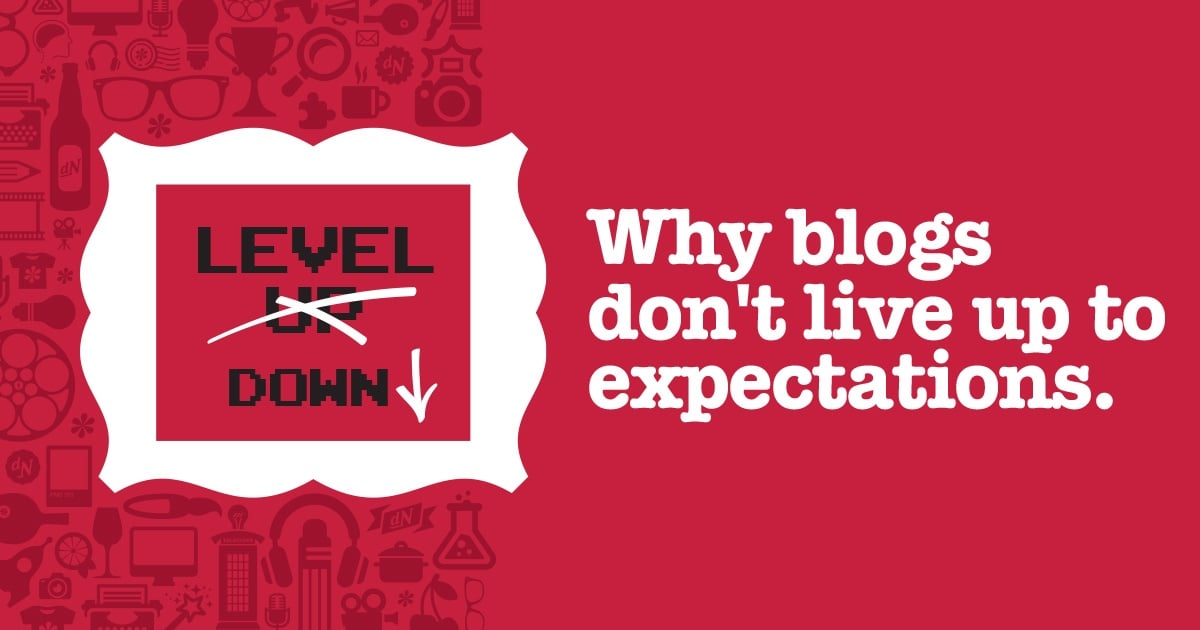You’ve heard it a million times, in a million different ways: “You should be blogging.”
Well, should you?
Almost every company can benefit from maintaining a blog—it makes your site more visible on search engine results pages. It helps you connect with customers. And it creates reusable content that you can promote across a variety of channels.
But blogging takes time. And there’s more to it than just writing—you also need compelling imagery to help your content stand out. You need a place to house it on your website. And you need a promotion strategy to make sure it gets read.
So before you jump into the water without measuring how deep it goes, ask yourself, “What can I reasonably expect from a blog?”
Expectations Vs. Reality

Here’s the thing about misplaced expectations—they’ll kill a blog before it gets the chance to find its footing, wasting your team’s time and effort, and frustrating everyone in the process.
Too often, companies decide to start a blog then stop once they realize it takes real work and planning. A blog also needs time to mature and grow to be truly effective. So if you’re only interested in blogging for short term gains—sorry—you’re looking in the wrong place.
Starting a blog won’t be the magic bullet that solves all your marketing challenges overnight, but if you stick to it and have a little patience, it can be immensely helpful in creating brand recognition, engaging your customers and driving sales in the long run.
Where It All Goes Wrong
There are a number of things you can do to make sure your blog is successful:
- You can post on a regular basis.
- You can promote new blogs on social media, in e-newsletters, or even submit them to local publications as opinion pieces.
- You can create a form that allows readers to subscribe to your blog on the home page of your website.
- You can add more graphics and visual content to your blogs.
The list goes on and on. But there are a few surefire ways to render your hard work ineffective.
Don’t want to see your blog sit unread and unloved on your website? Want to see a return on your efforts? Take a lesson from these biggest blogging pitfalls:
1. You lack a clear goal.
Every marketing activity needs a SMART goal (a goal that’s specific, measurable, attainable, relevant and timely). Blogs are no exception. Every post should serve a purpose, whether it’s freeing up a customer service rep’s time by answering an FAQ in depth, or driving traffic to a new page on your website.
Now here’s the kicker—you can’t just focus on your own goals. You also need to consider what your audience wants out of it.
Ask yourself what content your customer is looking for in your blog. Information? Advice? Entertainment? If you can’t offer anything in return for their time and attention, why should they bother?
2. You don’t understand your audience.
Speaking of your audience’s goals—do you know what they are? Can you list their pain points? Do you know their interests?
If you want a customer to read your blog (and really enjoy it), learn something about them first. Good customer profiles can help you pick relevant topics, give you direction on tone and voice, and tell you where to promote your blog.
If you don’t already have established customer personas as a part of your inbound marketing plan, put a couple together before starting your blog. And before you hit publish, do a quick check to make sure your post appeals to their interests, is genuinely helpful and gets them excited/interested/curious enough to click on your call-to-action (CTA).
That brings us to our next point:
3. You don’t have a call-to-action.
A good blog starts a conversation—don’t let it end once the reader finishes that last sentence. CTAs offer additional information, resources and assistance that interested readers can follow up on.
Not sure what your call-to-action should be? That’s when having a goal really comes in handy. An effective CTA speaks to your goals AND your customer’s goals. And it uses action-oriented verbiage to spark action.
4. You don’t learn and adapt.
A blog takes time and a fair amount of tweaking to establish itself—and you won’t get anywhere without input.
Analytics are essential to measuring the effectiveness of your blog so you can make the necessary adjustments to make it more reader-friendly, helpful and interesting. If you use a program like Hubspot (our preferred CRM and inbound marketing platform), you’ll get insights into how many people are reading it, how long they read it for, what links they’re clicking—all that good stuff. You can also use tools from Google Analytics Solutions, some of which are free.
5. You set it and forget it.
The work doesn’t end once you hit publish. Every blog needs occasional updating. After all, the times change. Your opinions change. Processes, best practices, the services you offer…all of it can change. And as your blog ages, the information on it does too.
If you’re not continuously adding new posts, the first thing your customer sees will feel out of date and out of place—will your company seem that way too?
The good news is that an old, outdated post can still be salvaged (at least some of the time). By periodically updating your blog, you make your posts more relevant and you boost your search rankings too. Plus, it gives you the chance to add links to other relevant articles you wrote after that blog was published.
If you love your customers, set them free.
Remember the old saying: “If you love something, set it free—if it comes back, it’s yours; if it doesn’t, it never was.” That applies to your readers just as much as it does your lover. (Though it’s probably best not to confuse the two.)
Blogs shouldn’t be one-sided advertisements. Use blogging as a way to put the customer first. Offer them high-quality, trustworthy content that helps them makes decisions on their own—even if it means letting them go elsewhere so they can find what they’re looking for.
At the end of the day, if your blog does its job and your product/service is a good fit, they’ll come back to you when the time is right.
Want to learn more about blogging best practices? Our copywriter, Kelly, can help you dive into the details. Shoot her an email and start a conversation.
{{cta(‘0ca11429-09e9-4147-9f07-318d80587ef1’)}}


